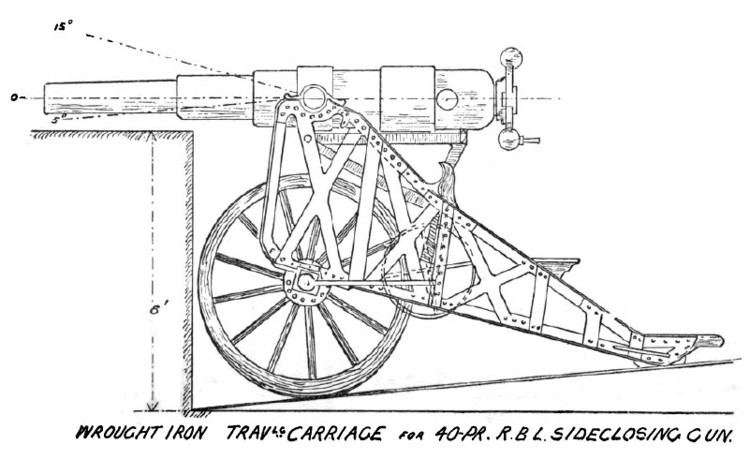Place of origin United Kingdom Designer W.G. Armstrong Co. | In service 1860s - 1900? | |
 | ||
Type Naval gun
Fortification gun Used by United Kingdom
Australian colonies Wars New Zealand Land Wars
Bombardment of Kagoshima | ||
The Armstrong RBL 40 pounder gun was introduced into use in 1860 for service on both land and sea. It used William Armstrong's new and innovative rifled breechloading mechanism. It remained in use until 1902 when replaced by more modern Breech Loading (BL) guns.
Contents
Design history
The Armstrong "screw" breech had already proved successful in the RBL 12 pounder 8 cwt field gun, and the British Government requested it be implemented for heavier guns despite Armstrong's protests that the mechanism was unsuited to heavy guns. Guns were produced at both the Royal Gun Factory in Woolwich, and the Elswick Ordnance Company.
Like other early Armstrong guns they were rifled on a polygroove system, firing a variety of lead coated projectiles.
Variants
The first version weighed 32 cwt, followed by the 35 cwt version which introduced a longer and stronger breech-piece. A 32 cwt variant having a horizontal sliding wedge breech instead of the Armstrong screw with vertical vent-piece was introduced in 1864 as an attempt to address the perceived weaknesses of the screw-breech design. It was withdrawn from service by 1877.
From 1880 a small number of 35 cwt guns had their trunnion rings rotated to the left to allow the vent-piece to open horizontally to the right, being known as "side-closing" guns. They differed from the wedge guns in that the vent piece was still locked in place by tightening the screw behind it.
Naval service
The gun was recommended in 1859 for the Navy as a broadside or pivot gun.
An officer from HMS Euryalus described the gun's performance at the Bombardment of Kagoshima of August 1863:
Following the bombardment of Alexandria in 1882, as part of the Anglo-Egyptian War, an armed train was employed. One 40 Pounder RBL was mounted onto the train and manned by men of the Royal Navy. It saw some action at the battle of Kassasin on 1 september 1882.
Land service
A number of different carriages for guns employed for Land Service were available. A wooden siege carriage with wheels and attached limbers, enabled the guns to be drawn by teams of heavy horses.
For guns mounted in fortifications they could be mounted on two different types of carriage. The first was an iron traversing carriage, enabling the gun to be traversed right and left, with recoil being absorbed with a carriage being mounted on a slide. Others were mounted on high "siege travelling carriages" for use as semi-mobile guns in forts, firing over parapets.
A number were used by many British Volunteer Artillery Batteries to whom they were issued after 1889. Most remained in use in this role until 1902. A number were used for some years afterwards as saluting guns.
Indian subcontinent
An RBL 40-pounder Armstrong breechloader appears to be present in a photograph by John Burke (photographer) from the Second Anglo-Afghan War (November 1878 - September 1880). The war began when Great Britain, fearful of what it saw as growing Russian influence in Afghanistan, invaded the country from British India. The first phase of the war ended in May 1879 with the Treaty of Gandamak, which permitted the Afghans to maintain internal sovereignty but forced them to cede control over their foreign policy to the British. Fighting resumed in September 1879, after an anti-British uprising in Kabul, and finally concluded in September 1880 with the decisive Battle of Kandahar.
Colony of Victoria service
The Australian colony of Victoria received six 35 cwt guns in August 1865. They were used as mobile coast fortification guns with one gun being fitted to the colonial sloop Victoria during 1866 & 1867. Later four of the guns were used as field guns at Hastings. Three of these guns are known to survive.
Colony of Tasmania service
As a result of the Jervois-Scratchley reports of 1877 into the defence of Australian colonies following the withdrawal of British troops, the Launceston Volunteer Artillery Corps in Tasmania acquired 2 guns on late-model iron carriages with iron wheels, which they continued to operate until at least 1902.
